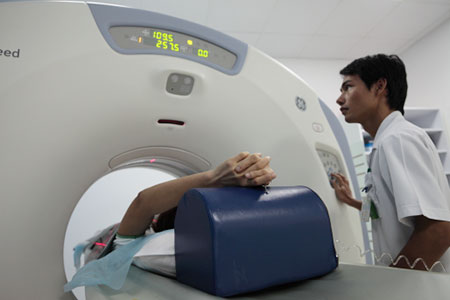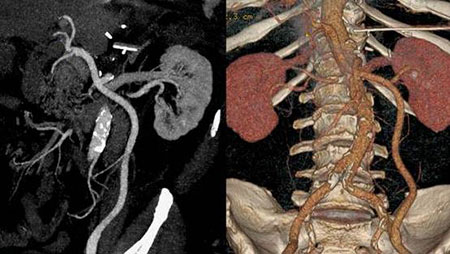Table of contents
What is a CT Scan?
- CT scanning uses special x-ray equipment that produces cross sectional images of the body. The unit comprises a gantry which is large squarish machine with a wide hole in it and a table which the patient lies on.
- Conventionally, images were obtained slice by slice sequentially but with multidetector-CT in the spiral mode, large volumes of the body can be scanned rapidly and accurately. The digital information for the scanner is converted to images that can be viewed in any 3D orientation.
What are the benefits of the 16-Slice CT Scanner?
- The 16-Slice CT Scanner captures multiple images of a patient’s anatomy in a matter of seconds and presents information 3-dimensionally. This means the images of the body are now taken much faster, therefore reducing the examination time and increasing your comfort.
- The information provided is more detailed due to the ability of the scanner to produce thin-slice images; this allows early detection of certain diseases in a less invasive manner.
The 16-Slice CT Scanner provides non-interventional advanced clinical application, such as:
- CT Angiography
- Lung screening
- “Fly-through” colon examinations (Virtual colonoscopy)
- Routine and non-routine examinations of the:
- head, neck and thorax
- liver, spleen, pancreas and kidneys
- abdomen and pelvis
- blood vessels
- oncology/cancer management
- pulmonary embolism
How should I prepare for the procedure?
- You will be required before your appointment to fill a questionnaire and to sign a consent form
- Before the examination, you will be required to change into a gown provided and to remove hairpins, jewellery, eyeglasses, hearing aids and any removable dental work that could obscure the images.
- You may also be asked to refrain from eating or drinking anything for four (4) hours before the examination.
- If you are or may be pregnant, kindly inform the Doctor or the Radiographer.
- Before receiving the contrast, tell your health care provider if you take the diabetes medication metformin (Glucophage). People taking this medicine may need to stop temporarily
What will I experience during the procedure?
- You are required to lie still on the CT scanner table. During the procedure, you will be moved up and down, as well as slide in and out from the centre of the hole as the images are being taken.
- Depending on the type of the study being done, contrast medium may be administered intravenously or orally. Some patients find the taste of the contrast medium mildly unpleasant but tolerable. The intravenous injection will produce a warm flush sensation and on occasion nausea, both of which will subside subsequently.
- Your examination may also require the administration of an enema and/or air, if the colon is the focus of the study.
- You will be alone in the room during the scan; however, the Radiographer/Radiologist can see, hear and speak with you at all times. For paediatric patients, a parent/guardian who is not pregnant may be allowed in the room to comfort the patient and alleviate fear, but will be required to wear protective lead apron to prevent radiation exposure.

What else should I know?
- The procedure itself is relatively safe as the amount of the radiation is kept to an absolute minimum with the new technology.
- Many contrast media contain iodine, which may cause an allergic reaction in some individuals. Please inform the Doctor/Radiographer if you:
- have had an allergic reaction to iodine
- have any other known allergies
- are asthmatic
- If you are, or think you may be pregnant, you should let your Doctor and the Radiographer know before the CT examination. Nursing mothers, before resuming breast feeding should wait for 24 hours after oral or an injection of contrast medium.
- Request for a CT scan can be made directly by our Doctors or you can come with a prescription from an External Doctor.

How long does a CT Scan take?
- The picture-taking part of the test usually lasts less than 10 minutes, However, each examination may vary depending on the individual clinical requirements
When do I get the result?
- Your examination will be reviewed and reported by a Radiologist. Your referring Doctor will be informed immediately of any suspicious findings. You will receive a formal written report on the same day or within two (2) days depending on your clinical and diagnostic requirements.
How do I schedule the Scan?
For further information and appointments, kindly contact our Imaging Department at (08) 54 11 34 00



